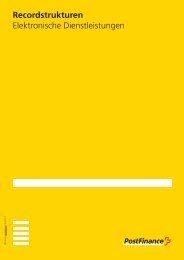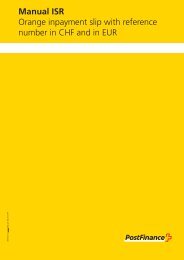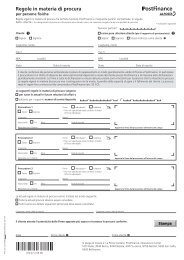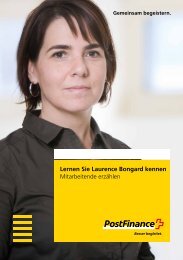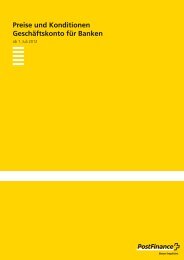Newsletter 2013-01 (PDF) - PostFinance
Newsletter 2013-01 (PDF) - PostFinance
Newsletter 2013-01 (PDF) - PostFinance
Create successful ePaper yourself
Turn your PDF publications into a flip-book with our unique Google optimized e-Paper software.
1 March <strong>2<strong>01</strong>3</strong><br />
Payment transactions in transition<br />
The Swiss financial centre is<br />
harmonising payment transactions.<br />
<strong>PostFinance</strong> is working alongside banks on<br />
the future of Swiss payment transactions. Switzerland<br />
currently has two independent payment<br />
systems that are closely linked and allow<br />
smooth payment transactions: the <strong>PostFinance</strong><br />
system and the Swiss Interbank Clearing (SIC)<br />
system. Until now, Switzerland’s high-quality<br />
dual system consisted of over ten standards<br />
and formats and seven different types of slip.<br />
As a result of increasing national and international<br />
regulatory requirements, these different<br />
standards and formats will no longer be<br />
developed in the long term. Instead, the aim<br />
is to achieve harmonisation.<br />
Harmonisation for transfers, debits and<br />
inpayment slips<br />
The areas of credit transfers, payment slips<br />
and direct debits were analysed in a study to<br />
explore the possibilities for harmonisation<br />
and alignment with European standards. The<br />
Swiss financial centre came to the conclusion<br />
that the Swiss transfer schemes should be<br />
The migration of payment transactions in Switzerland will form the basis for streamlined,<br />
uniform and cost-effective payment transaction processes.<br />
Imprint<br />
harmonised and substantially aligned to meet<br />
European standards. The area of direct debits,<br />
which currently consists of five schemes,<br />
will also be consolidated and aligned to SEPA<br />
standards.<br />
As far as inpayment slips are concerned, the<br />
existing documents will be combined and<br />
optimised. A new uniform slip will incorporate<br />
all the current advantages alongside additional<br />
functions such as the use of QR codes.<br />
Fewer errors thanks to the QR code<br />
Use of the QR code leads to a higher degree<br />
of automation during processing and an<br />
increase in the Straight Through Processing<br />
Rate (STP). There are many advantages to<br />
the QR code, not only for financial institutions<br />
but also for invoice issuers and payers.<br />
Harmonisation of Swiss payment transactions<br />
will form the basis for streamlined, uniform<br />
and cost-effective processes.<br />
“News from <strong>PostFinance</strong> for financial institutions”, Edition 1 / <strong>2<strong>01</strong>3</strong><br />
Publisher: Swiss Post, <strong>PostFinance</strong><br />
International Payments<br />
Nordring 8, CH-3030 Berne<br />
postfinance.ch / banks<br />
News from <strong>PostFinance</strong><br />
The QR code is gaining<br />
acceptance<br />
The square matrix made up<br />
of black and white dots was<br />
developed in 1994 by the<br />
Japanese software company<br />
Denso Wave and was initially<br />
used in logistics by automobile<br />
manufacturers.<br />
Now the QR code is gaining<br />
acceptance – mostly thanks to<br />
applications on smart-phones.<br />
Its uses range from downloading<br />
software to accessing<br />
websites and identifying<br />
products.<br />
QR stands for Quick Response.<br />
Special markings in three of<br />
the four corners show which<br />
way up it goes. The number<br />
of points contained in the<br />
matrix is between 11 times<br />
11 and 177 times 177.<br />
When scanned, this QR code<br />
takes you to migration-pt.ch<br />
to find out more about<br />
slip migration in Switzerland.<br />
Edited by: Dominik Hölz, Relationship Manager<br />
Layout: <strong>PostFinance</strong>, Communications, Public Relations<br />
4



